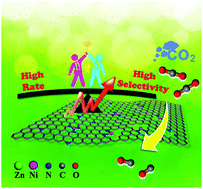Coordinatively unsaturated nickel–nitrogen sites towards selective and high-rate CO2 electroreduction†
Abstract
High Faradaic efficiency and appreciable current density are essential for future applications of the electrochemical CO2 reduction reaction (CO2RR). However, these goals are difficult to achieve simultaneously due to the severe side reaction – the hydrogen evolution reaction (HER). Herein, we successfully synthesized coordinatively unsaturated nickel–nitrogen (Ni–N) sites doped within porous carbon with a nickel loading as high as 5.44 wt% by pyrolysis of Zn/Ni bimetallic zeolitic imidazolate framework-8. Over the Ni–N composite catalysts, the CO current density increases with the overpotential and reaches 71.5 ± 2.9 mA cm−2 at −1.03 V (vs. a reversible hydrogen electrode, RHE), while maintaining a high CO Faradaic efficiency of 92.0–98.0% over a wide potential range of −0.53 to −1.03 V (vs. the RHE). Density functional theory calculations suggest that the CO2RR occurs more easily than the HER over the coordinatively unsaturated Ni–N site. Therefore, highly doped and coordinatively unsaturated Ni–N sites achieve high current density and Faradaic efficiency of the CO2RR simultaneously, breaking current limits in metal–nitrogen composite catalysts.



 Please wait while we load your content...
Please wait while we load your content...